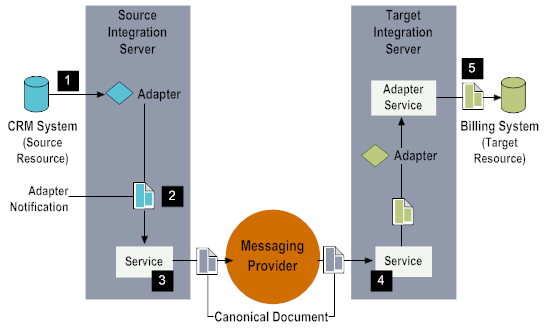

Step | Description |
1 | The source resource makes a data change. |
2 | Integration Server receives notification of the change on the source. For example, in the above illustration, an adapter checks for changes on the source. When the adapter recognizes a change on the source, it sends an adapter notification that contains information about the change that was made. The adapter might either publish the adapter notification or directly invoke a service passing it the adapter notification. For more information about adapter notifications, see the guide for the specific adapter that you are using with a source resource. |
3 | A service that you create receives the notification of change on the source. For example, it receives the adapter notification. This service maps data from the change notification document to a canonical document. A canonical document is a common business document that contains the information that all target resources will require to incorporate data changes. The canonical document has a neutral structure among the resources. For more information, see
Canonical Documents. After forming the canonical document, the service publishes the canonical document. The targets subscribe to the canonical document. |
4 | On a target, the trigger that subscribes to the canonical document invokes a service that you create. This service maps data from the canonical document into a document that has a structure that is native to the target resource. The target resource uses the information in this document to make the equivalent change. |
5 | The target resource makes a data change that is equivalent to the change that the source initiated. If the target resource is using an adapter, an adapter service can be used to make the data change. For more information about adapter services, see the guide for the specific adapter that you are using with a target resource. |